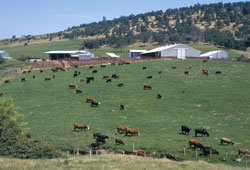
Grazing forage kochia and calving later in the season are just two examples of reducing feeding costs for livestock. In other places, producers feed protein supplements, augment with cheap grain such as wheat mids or use mineral supplements to increase livestock distribution in a pasture.
Amanda Hancock works to find ways to extend fall grazing on crop aftermath at the North Dakota State University Central Grasslands Research Extension Center.
“If we can extend our traditional grazing season for one month, we can save feeding 107,094 pounds of dry harvested forage,” she says.
She calculates that savings based on hay generally baled at about 15 percent moisture and assumes a 1,373-pound cow will eat roughly 40 pounds of feed per day. A herd of 100 cows will eat about two tons of hay per day.
Using the custom rates provided by NDSU Extension, a tractor with a loader costs about $25 an hour to run, and Hancock estimates that it takes about one hour to feed a 100-head herd. With $25 for equipment and $45 per ton of hay, she estimates that it costs about $115 a day to feed the herd.
At $115 per day to feed cows harvested forages, “we have a savings of $3,450 if we can even extend our grazing season for 30 days,” Hancock says.
So far, Hancock and her collaborators have used aftermath grazing of harvested corn, alfalfa and barley fields to extend their grazing season by three months and save $10,350.
It might not work on every range, but in Devils Tower, Wyo., Ogden Driskill lets his sheep show the cattle where the forage is. Most producers will say sheep are followers not leaders, and it is true that each individual sheep will stay within about 50 feet of another sheep if possible. Yet in the rolling hills of Wyoming, the sheep travel where cattle first avoid. Driskill’s cattle follow the flock’s trails to more forage so both classes of livestock – and the range – benefit.
“The sheep make trails the cattle will follow so the cattle find forage where they would never think to look,” Driskill says.
